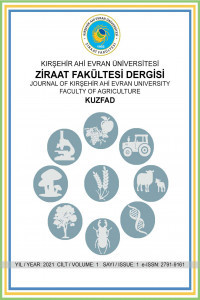Seralarda Yalıtım Değerleri Farklı Isı Perdelerinin Enerji Tasarrufuna Etkisinin Belirlenmesi: Kırşehir İli Örneği
Seralarda yapılan üretimde ısıtma, verim ve kaliteyi önemli ölçüde etkilemektedir. Ancak ısıtma yapılan
seralarda ısı koruma önlemleri alınmaması durumunda, yetiştiriciliğe uygun iç ortam sıcaklıklarını
sağlamak için, önemli miktarda ısı enerjisine gereksinim duyulmaktadır. Bu önemli miktarda enerjinin
azaltılması için en çok kullanılan teknik yöntemlerden bir tanesi ısı perdelerinin kullanılmasıdır. Ancak,
ısı perdelerinin amaca uygun olarak seçilmesi ve yalıtımlarının sağlanması ısı korunumu açısından son
derece önemlidir. Çalışmada dört farklı serada (Sera-1: ısı perdesi yok, Sera-2: ısı perdeli yalıtım kötü,
Sera-3: ısı perdeli yalıtım orta ve Sera-4: ısı perdeli yalıtım iyi) ısı enerjisi korunumu amacıyla kullanılan
ısı perdelerinin enerji tasarrufuna etkisi araştırılmıştır. Serada gereksinim duyulan enerjinin belirlenmesi
için domates yetiştirilmesi düşünülen serada iç ortamının yıl boyunca gündüz ve gece 20/15°C’de
tutulması için gerekli olan ısı enerjisi miktarı hesaplanmıştır. Çalışma sonucunda, ısı perdelerinin ısı
tasarruf oranları perdelerin yalıtımına bağlı olarak %5.61-24.30 arasında değiştiği belirlenmiştir. Bunun
yanında enerji korunumu sayesinde yakıt olarak kullanılan fosil yakıtların miktarını azalttığı ve
yakıtların atmosfere saldığı karbondioksitin azaltılması bakımından da olumlu sonuçlar verdiği
belirlenmiştir. Sonuç olarak ısı perdelerinin ısı enerjisi tasarrufu sağladığı ancak ısı perdelerinin yalıtım
durumlarının kullanımından daha önemli olduğu sonucuna varılmıştır.
Anahtar Kelimeler:
Isı gücü gereksinimi, enerji korunumu, fosil yakıtlar, Heat power requirement, energy conservation, fossil fuels
Determination of The Effect of Thermal Screens with Different Insulation Values on Energy Saving in Greenhouses: Example of Kırşehir Province
Heating has a significant impact on yield and quality in greenhouse production. However, if heat
preservation precautions are not taken in heated greenhouses, a significant amount of heat energy is
required to provide suitable indoor temperatures for cultivation. One of the most used technical methods
to reduce this significant amount of energy is the use of thermal screens. However, choosing the thermal
screens in accordance with the purpose and providing their insulation is extremely important in terms
of heat preservation. In the study, the effect of thermal screens used for the purpose of heat energy
conservation on energy saving in four different greenhouses (Greenhouse-1: no screen, Greenhouse-2:
poor insulation with thermal screen, Greenhouse-3: insulation with screen is medium and Greenhouse4: insulation with screen is good) was investigated. To assess the energy needed in the greenhouse, the
amount of heat energy required to keep the indoor environment at 20/15°C day and night throughout the
year in the greenhouse where it is planned to grow tomatoes has been calculated. As a result of the study,
it was determined that the heat saving rates of the thermal screens vary between 5.61-24.30%depending
on the insulation of the screens. In addition, it has been determined that due to the energy conservation,
the amount of fossil fuels used is reduced and positive results are observed in terms of reducing the
carbon dioxide released by the fuels into the atmosphere. As a result, it has been concluded that the
thermal screens provide thermal energy savings, but the insulation status of the thermal screens is more
important than their use.
Keywords:
Heat power requirement, energy conservation, fossil fuels,
- Başlangıç: 2021
- Yayıncı: Kırşehir Ahi Evran Üniversitesi
Sayıdaki Diğer Makaleler
Besi Sığırlarında Refah Kalitesinin Değerlendirilmesi: İyi Besleme, İyi Barındırma
Bahadır ALTUN, Zerrin TAŞ, Nuray AKBAYIR, Hüseyin KAÇMAZ, Samet KURT, Mehmet Oktay AKGÜL, Ahmet BİRGE, Menise Damla AYDIN, Gülden YILDIRIM, Ahmet ÖZATEŞ
2021 Yılında Görülen Kuraklığın Van İlindeki Bazı Su Kaynakları ve Balıkçılığa Etkiler
Zeytin Karasuyunun Bazı Kültür Bitkileri Üzerine Etkisi
Aspir (Carthamus tinctorious L.) Tarımında Çiftçi Eğiliminin Belirlenmesi Mucur İlçesi Örneği
